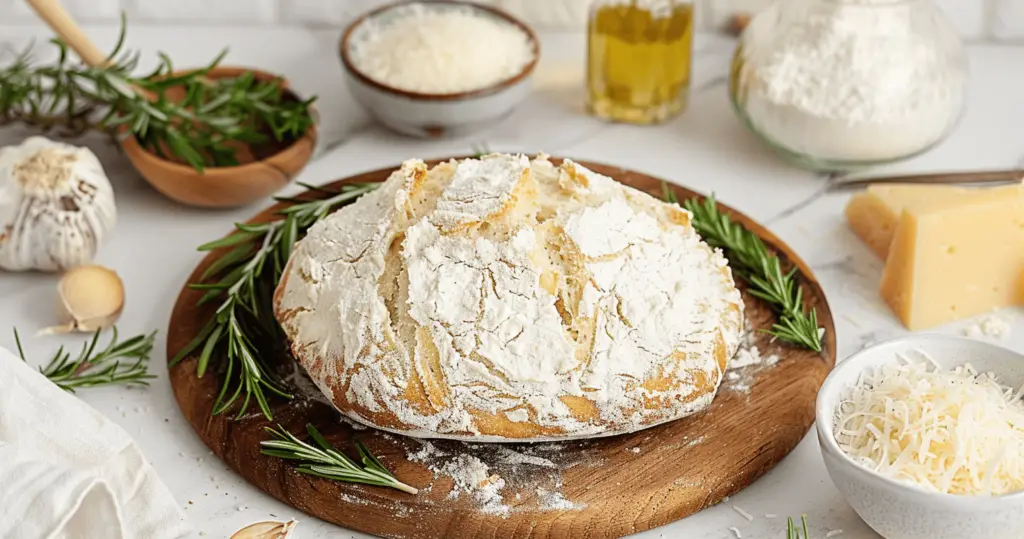Rosemary Parmesan bread is a delightful, aromatic bread that combines the earthy flavor of rosemary with the rich taste of Parmesan cheese. This bread is perfect for a variety of occasions, whether served as a side dish, used in sandwiches, or enjoyed on its own. The combination of herbs and cheese creates a unique taste that appeals to many palates.

Overview of Rosemary Parmesan Bread
This bread is a type of savory bread that integrates fresh or dried rosemary and grated Parmesan cheese into the dough. The process of making this bread involves a few steps that ensure the flavors are well incorporated and the texture is perfect. It can be made using either a traditional bread-making method or with the help of a bread machine.
Brief History and Cultural Significance
Bread has been a staple in various cultures for centuries, and flavored breads like Rosemary Parmesan bread have evolved to add variety and enhance meals. The use of rosemary in cooking dates back to ancient civilizations, where it was prized for its flavor and medicinal properties. Parmesan cheese, originating from Italy, has long been valued for its strong flavor and versatility in cooking.
Preparation Phase & Tools to Use
Prep Time: 20 minutes
Cook Time: 30 minutes
Cool Time: 20 minutes
Total Time: 1 hour 10 minutes
Servings: 8-10
Yield: 1 loaf
Preparing Rosemary Parmesan bread involves gathering the right tools and ingredients. Essential tools include a large mixing bowl, a wooden spoon or dough hook, a baking sheet, and a cooling rack.
Essential Tools and Equipment
- Large Mixing Bowl: For mixing the dough.
- Wooden Spoon or Dough Hook: For kneading the dough.
- Baking Sheet: For baking the bread.
- Cooling Rack: To cool the bread after baking.
Importance of Each Tool
Each tool plays a critical role in the bread-making process. The mixing bowl allows for easy blending of ingredients, the wooden spoon or dough hook helps develop the dough’s gluten, the baking sheet provides even baking, and the cooling rack prevents the bread from becoming soggy as it cools.
Preparation Tips
- Fresh Ingredients: Use fresh rosemary and high-quality Parmesan cheese for the best flavor.
- Proper Kneading: Ensure the dough is kneaded well to develop the right texture.
- Temperature Control: Make sure the dough is proofed at a warm, stable temperature to rise properly.
Ingredients List
- 3 cups all-purpose flour
- 2 teaspoons active dry yeast
- 1 teaspoon sugar
- 1 cup warm water (110°F/45°C)
- 2 tablespoons olive oil
- 1 teaspoon salt
- 1 tablespoon chopped fresh rosemary (or 1 teaspoon dried)
- 1/2 cup grated Parmesan cheese
Step-by-Step Instructions
- Prepare the Yeast
- Dissolve 2 teaspoons of active dry yeast and 1 teaspoon of sugar in 1 cup of warm water.
- Let it sit for about 5 minutes until frothy.
- Mix the Ingredients
- In a large mixing bowl, combine 3 cups of all-purpose flour and 1 teaspoon of salt.
- Add the yeast mixture and 2 tablespoons of olive oil.
- Mix until a rough dough forms.
- Add the Flavorings
- Stir in 1 tablespoon of chopped fresh rosemary and 1/2 cup of grated Parmesan cheese.
- Knead the dough on a lightly floured surface for about 8-10 minutes until smooth and elastic.
- First Rise
- Place the dough in a lightly oiled bowl, cover with a damp cloth, and let it rise in a warm place for about 1 hour or until doubled in size.
- Shape the Dough
- Punch down the dough and shape it into a loaf.
- Place the loaf on a baking sheet lined with parchment paper.
- Second Rise
- Cover the loaf with a damp cloth and let it rise for another 30 minutes.
- Bake the Bread
- Preheat the oven to 375°F (190°C).
- Bake the bread for 25-30 minutes or until golden brown and sounds hollow when tapped.
- Cool the Bread
- Transfer the bread to a cooling rack and let it cool completely before slicing.
Side Dish Recommendations
Rosemary Parmesan bread pairs wonderfully with a variety of side dishes, enhancing meals with its unique flavor. Here are eight side dish recommendations that complement the aromatic and cheesy notes of this bread:
Caprese Salad
Caprese Salad is a simple yet elegant combination of fresh tomatoes, Mozzarella cheese, and basil, drizzled with olive oil and balsamic vinegar. The freshness of the salad contrasts beautifully with the savory flavors of the bread.
Bruschetta
Bruschetta features toasted bread topped with a mixture of diced tomatoes, garlic, basil, and olive oil. Adding slices of Rosemary Parmesan bread elevates this classic appetizer with an added depth of flavor.
Tomato Basil Soup
A warm bowl of Tomato Basil Soup complements the savory, herb-infused bread. Dip slices of Rosemary Parmesan bread into the soup for a delightful combination of flavors and textures.
Grilled Vegetables
Grilled vegetables such as zucchini, bell peppers, and eggplant pair excellently with Rosemary Parmesan bread. The smoky flavor of the vegetables enhances the bread’s earthy rosemary and rich Parmesan notes.
Garlic Butter Shrimp
Garlic Butter Shrimp is a quick and delicious dish that pairs perfectly with the bread. The buttery, garlicky shrimp complements the herby and cheesy bread, making for a satisfying meal.
Caesar Salad
Caesar Salad, with its creamy dressing and crunchy croutons, pairs well with Rosemary Parmesan bread. The bread can even be toasted and used as croutons for an extra layer of flavor.
Roasted Chicken
Roasted Chicken, seasoned with herbs and spices, is a hearty main course that goes well with the bread. The bread’s flavors enhance the savory, juicy chicken, creating a balanced and flavorful meal.
Antipasto Platter
An antipasto platter with an assortment of cured meats, olives, roasted vegetables, and cheeses, including slices of Rosemary Parmesan bread, makes for a perfect appetizer or side dish. The variety of flavors and textures offers something for everyone.
Nutritional Information & Health Benefits
Understanding the nutritional profile and health benefits of Rosemary Parmesan bread can help you appreciate its value in a balanced diet.
Caloric Content and Macronutrient Breakdown
A typical slice of Rosemary Parmesan bread (about 50 grams) contains approximately:
- Calories: 150
- Protein: 5 grams
- Fat: 4 grams
- Carbohydrates: 22 grams
Rich Source of Protein and Calcium
The Parmesan cheese in the bread provides a good source of protein and calcium, essential for muscle growth and bone health. Additionally, the bread offers a moderate amount of dietary fiber, contributing to digestive health.
Benefits for Bone Health
Due to its calcium content, Rosemary Parmesan bread can contribute to maintaining strong bones and teeth. Regular consumption of calcium-rich foods helps prevent osteoporosis and other bone-related conditions.
Comparison with Other Breads
Compared to plain white bread, Rosemary Parmesan bread offers additional nutrients and flavors from the added herbs and cheese. It tends to be more satisfying and can enhance the overall nutritional value of a meal.
Common Mistakes to Avoid & How to Perfect the Recipe
Making Rosemary Parmesan bread at home can be a rewarding experience, but it’s essential to avoid common mistakes to achieve the best results.
Overkneading the Dough
Overkneading the dough can result in a tough, dense bread. Knead the dough until it is just smooth and elastic, usually about 8-10 minutes.
Incorrect Measuring of Ingredients
Accurate measurement of ingredients is crucial for consistent results. Use a kitchen scale to measure flour and other dry ingredients for precision.
Insufficient Rising Time
Allow the dough to rise fully to develop the best texture and flavor. Rushing this step can lead to dense, under-risen bread.
Solutions to Common Issues
- Dry Dough: If the dough is too dry, add a small amount of water, one tablespoon at a time, until the desired consistency is reached.
- Sticky Dough: If the dough is too sticky, add a small amount of flour, one tablespoon at a time, until it becomes manageable.
- Uneven Baking: Ensure the oven is preheated properly and place the bread in the center of the oven for even baking.
Tips, Notes, Storing and Reheating
Tips for Perfect Rosemary Parmesan Bread
- Use Fresh Ingredients: Fresh rosemary and high-quality Parmesan cheese will yield the best flavor.
- Accurate Measurements: Ensure precise measurements of all ingredients for consistent results.
- Proper Kneading: Knead the dough until it’s smooth and elastic, but avoid overkneading to prevent a tough texture.
- Warm Environment for Rising: Let the dough rise in a warm, draft-free area to ensure proper fermentation.
Notes on Ingredients and Variations
- Alternative Flours: You can experiment with whole wheat flour or a mix of different flours for a more rustic bread.
- Additional Herbs: Add other herbs like thyme or oregano for a more complex flavor profile.
- Cheese Variations: Try using different hard cheeses like Pecorino Romano or Asiago for a different twist.
Storing Rosemary Parmesan Bread
- Room Temperature: Store the bread in a paper bag or bread box at room temperature for up to 3 days.
- Freezing: To freeze, wrap the bread tightly in plastic wrap and then in aluminum foil. Freeze for up to 3 months. Thaw at room temperature before use.
Reheating Rosemary Parmesan Bread
- Oven Method: Preheat your oven to 350°F (175°C). Wrap the bread in aluminum foil and heat for 10-15 minutes until warm.
- Microwave Method: Place a slice on a microwave-safe plate and cover with a damp paper towel. Microwave on low power for 10-20 seconds.
FAQs
How long does homemade Rosemary Parmesan bread last? When stored at room temperature in a paper bag or bread box, homemade Rosemary Parmesan bread lasts up to 3 days. For longer storage, freeze the bread for up to 3 months.
Can I use dried rosemary instead of fresh? Yes, you can use dried rosemary. However, use about one-third the amount of dried rosemary compared to fresh, as dried herbs are more potent.
What is the best way to achieve a crispy crust? To achieve a crispy crust, bake the bread with a steam pan in the oven. Place a pan of hot water on the bottom rack while baking, or mist the oven with water before placing the bread inside.
Is it possible to make this bread gluten-free? Yes, you can make a gluten-free version using a gluten-free all-purpose flour blend. Be sure to add a binding agent like xanthan gum if it’s not already included in the blend.
Can I add other ingredients to the bread? Absolutely! You can add ingredients like garlic, sun-dried tomatoes, or olives to enhance the flavor of your Rosemary Parmesan bread.
Conclusion
Rosemary Parmesan bread is a delicious, aromatic bread that enhances any meal. Making it at home allows you to enjoy its fresh, rich flavors at their peak. By following the detailed steps, tips, and recommendations provided, you can perfect your bread-making skills and enjoy this savory delight whenever you like.
Print
Rosemary Parmesan bread
Description
Learn to make delicious Rosemary Parmesan bread at home with our step-by-step guide, tips, and FAQs. Perfect your bread-making skills today!
Ingredients
Ingredients List
- 3 cups all-purpose flour
- 2 teaspoons active dry yeast
- 1 teaspoon sugar
- 1 cup warm water (110°F/45°C)
- 2 tablespoons olive oil
- 1 teaspoon salt
- 1 tablespoon chopped fresh rosemary (or 1 teaspoon dried)
- 1/2 cup grated Parmesan cheese
Instructions
Step-by-Step Instructions
- Prepare the Yeast
- Dissolve 2 teaspoons of active dry yeast and 1 teaspoon of sugar in 1 cup of warm water.
- Let it sit for about 5 minutes until frothy.
- Mix the Ingredients
- In a large mixing bowl, combine 3 cups of all-purpose flour and 1 teaspoon of salt.
- Add the yeast mixture and 2 tablespoons of olive oil.
- Mix until a rough dough forms.
- Add the Flavorings
- Stir in 1 tablespoon of chopped fresh rosemary and 1/2 cup of grated Parmesan cheese.
- Knead the dough on a lightly floured surface for about 8-10 minutes until smooth and elastic.
- First Rise
- Place the dough in a lightly oiled bowl, cover with a damp cloth, and let it rise in a warm place for about 1 hour or until doubled in size.
- Shape the Dough
- Punch down the dough and shape it into a loaf.
- Place the loaf on a baking sheet lined with parchment paper.
- Second Rise
- Cover the loaf with a damp cloth and let it rise for another 30 minutes.
- Bake the Bread
- Preheat the oven to 375°F (190°C).
- Bake the bread for 25-30 minutes or until golden brown and sounds hollow when tapped.
- Cool the Bread
- Transfer the bread to a cooling rack and let it cool completely before slicing.
Notes
- Alternative Flours: You can experiment with whole wheat flour or a mix of different flours for a more rustic bread.
- Additional Herbs: Add other herbs like thyme or oregano for a more complex flavor profile.
- Cheese Variations: Try using different hard cheeses like Pecorino Romano or Asiago for a different twist.


Leave a Comment